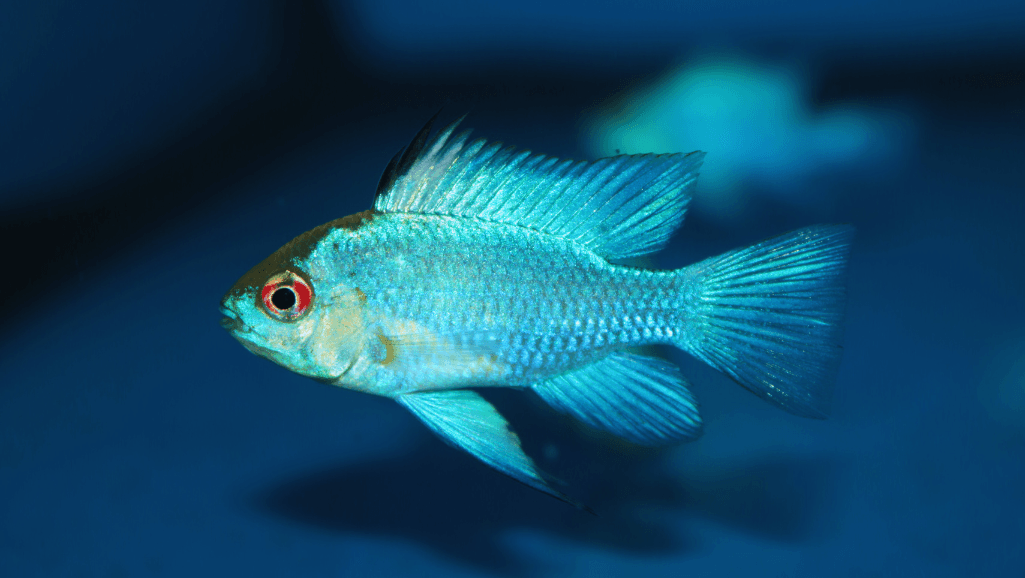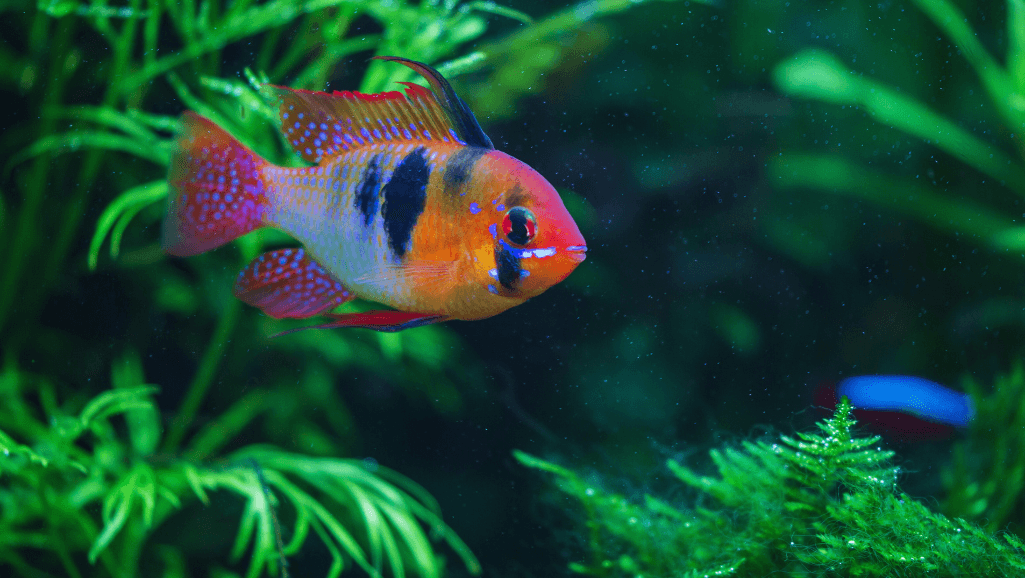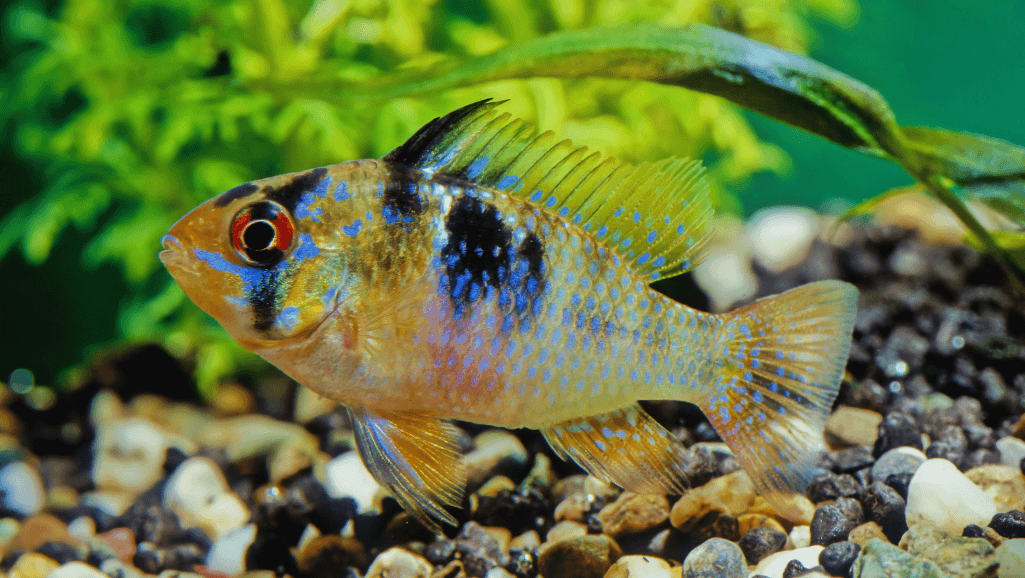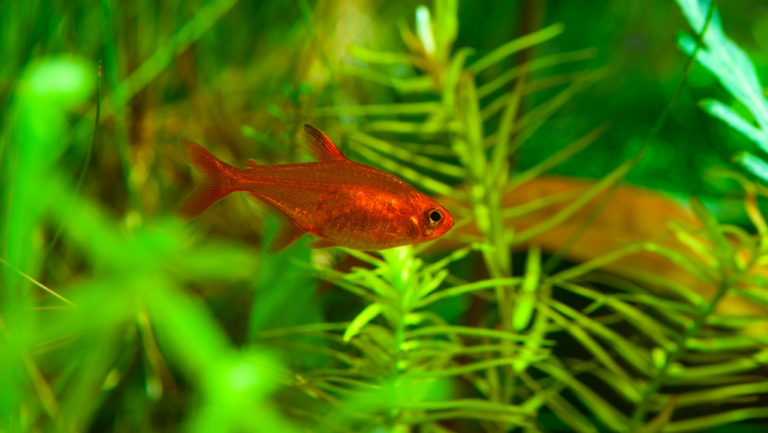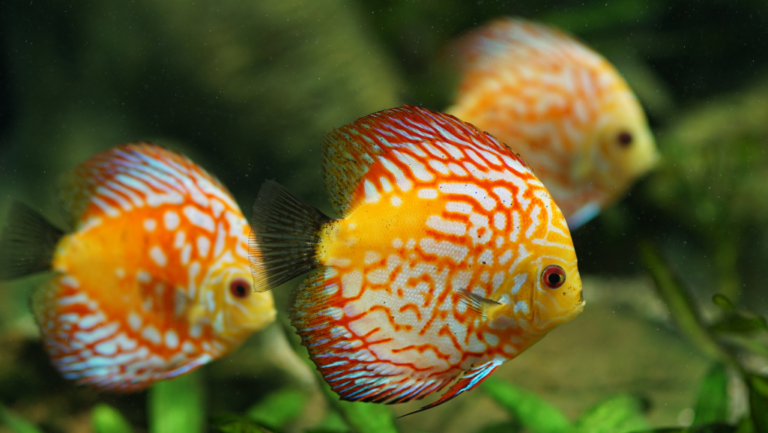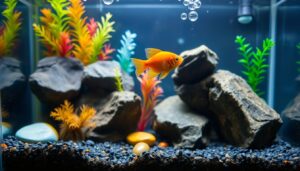The Electric Blue Ram is a stunning freshwater aquarium fish. It captivates hobbyists with its vibrant colors. This dwarf cichlid, a color morph of the ram cichlid, brings a splash of brilliance to any tank. Native to South America, these small but mighty fish require special care to thrive in home aquariums.
Electric Blue Rams typically grow to 1.5-2.5 inches in length. This makes them perfect for smaller tanks. With proper care, these South American cichlids can live up to 4 years. They bring joy to their owners with their active personalities and striking appearance.
These fish prefer soft water conditions and thrive in temperatures between 76-86°F. A pair of Electric Blue Rams can comfortably live in a 20-gallon tank. But larger spaces allow for more natural behavior. They’re known for their breeding habits, often producing multiple spawns throughout their lifetime.
Key Takeaways
- Electric Blue Rams are a vibrant variety of dwarf cichlid
- They grow to 1.5-2.5 inches and can live up to 4 years
- These fish prefer soft water and warm temperatures
- A 20-gallon tank is suitable for a pair of Electric Blue Rams
- They require a balanced diet and stable water conditions
- Breeding is possible but can be challenging in community tanks
Introduction to Electric Blue Rams
Electric Blue Rams are a vibrant type of Blue Ram Cichlid. They catch the eye with their bright colors and lively nature. These small but charming fish come from the Orinoco River basin in Colombia and Venezuela. They love soft, warm waters.
Origin and Natural Habitat
In their home, Electric Blue Rams live in slow-moving streams and rivers. They like places with lots of plants and hiding spots. This is important to set up in a planted aquarium. They do well in water with a pH between 5.0 and 7.5 and temperatures between 78°F and 85°F (25°C to 29°C).
Physical Characteristics
Electric Blue Rams are a beautiful sight in any aquarium. Their bodies shine with iridescent blues, with red, yellow, and black accents. Males show off more vibrant colors and have longer fins than females. They grow up to 4 inches (10 cm) long, fitting well in smaller tanks.
Lifespan and Size
With the right care, Electric Blue Rams can live up to 4 years. They become sexually mature between four to six months old, reaching 2 to 2.5 inches in size. Despite their small size, they have big personalities and are fun to watch in well-kept aquariums.
| Characteristic | Details |
|---|---|
| Maximum Size | 10 cm (4 inches) |
| Average Lifespan | Up to 4 years |
| Ideal Temperature | 78 – 85°F (25 – 29°C) |
| Water pH | 5.0 – 7.5 |
Electric Blue Ram Tank Setup
Creating the right home for your Electric Blue Rams is key to their well-being. These colorful fish need specific conditions to thrive. Let’s explore how to set up the perfect environment for them.
Tank Size Requirements
Electric Blue Rams don’t need huge tanks but do like room to move. A 20-gallon tank is ideal for a single pair. For two pairs, a 40-gallon tank is better. This size allows each pair to have their own space, reducing stress and encouraging natural behavior.
Water Parameters and Temperature
These vibrant cichlids prefer warmer water. Aim for a temperature of 84-86°F (29-30°C). They do well in soft water with a pH of 5.0 to 7.0. Water hardness should be between 6-14 dGH. Regular water changes are crucial to keep these conditions stable.
Filtration and Lighting
Effective filtration is vital for Electric Blue Rams. A reliable filter system ensures clean, well-oxygenated water. Moderate to bright lights are best, especially for a planted aquarium setup.
Substrate and Decorations
Opt for fine sand or smooth gravel as substrate. Electric Blue Rams enjoy digging, so avoid sharp materials. Add live plants, driftwood, and flat stones for hiding spots and breeding sites. A dark substrate enhances their vibrant colors.
| Tank Setup Element | Recommendation |
|---|---|
| Tank Size | 20 gallons for one pair, 40 gallons for two pairs |
| Temperature | 84-86°F (29-30°C) |
| pH Level | 5.0-7.0 |
| Water Hardness | 6-14 dGH |
| Substrate | Fine sand or smooth gravel |
| Decorations | Live plants, driftwood, flat stones |
Caring for Electric Blue Rams
Electric rams do well in a community aquarium with the right care. They need stable water and a clean environment to thrive. Regular water changes are key to their health, as they’re sensitive to water quality changes.
In a 20-gallon tank, a pair of electric rams can comfortably live. They like warm water, between 84-86°F (29-30°C). This means choosing the right tank mates is important.
Electric rams are usually peaceful but can get territorial during breeding. To avoid stress and aggression, add lots of hiding spots. Use plants, rocks, or driftwood to mimic their natural habitat.
“Electric Blue Rams are micro predators that need a high-protein diet consisting of insect larvae, fry, and invertebrates.”
Feeding them a varied, protein-rich diet is essential. Give them high-quality cichlid food and live or frozen foods. This diet is crucial for their health, especially if you’re breeding them.
With the right care, electric rams can live up to 4 years. Keep an eye on their behavior and health, as they can get sick from stress. Good water quality and a balanced diet will keep your electric rams vibrant and active in your aquarium.
Diet and Feeding Electric Blue Rams
Electric Blue Rams are popular in freshwater aquariums. They need a balanced diet to stay healthy. These colorful fish enjoy a variety of foods because they are omnivorous.
Recommended Foods
Give Electric Blue Rams high-quality flakes, pellets, and freeze-dried foods. Add live foods like brine shrimp and bloodworms for extra nutrition. Plant matter is also important for a complete diet.
Feeding Frequency and Amount
Feed your Electric Blue Rams 2-3 small meals a day. Make sure they can finish their food in 2 minutes. This prevents overfeeding and keeps the water clean.
Special Dietary Considerations
When they’re ready to breed, give them more protein-rich foods. Make sure the food is small enough for their mouths. Proper nutrition helps keep their colors bright and their health good.
| Food Type | Frequency | Benefits |
|---|---|---|
| Flakes/Pellets | Daily | Balanced nutrition |
| Live Foods | 2-3 times/week | Protein boost |
| Vegetables | 1-2 times/week | Fiber source |
It’s important to vary their diet to keep Electric Blue Rams healthy and colorful. By following these guidelines, your dwarf cichlids will thrive in their home.
Breeding Electric Blue Rams
Breeding Electric Blue Rams is a rewarding hobby for experienced aquarists. These South American cichlids mature at 4-6 months and pair up. To encourage breeding, create a habitat that mirrors their natural home.
Start with a 20-gallon breeding tank. Keep the water soft, with a pH of 5.5 to 6.5. Raise the temperature to 82°F (28°C). Add a flat rock for egg-laying. Well-fed pairs can spawn every month, laying 150-300 eggs.
Both parents care for the eggs and fry. The eggs hatch in about 40 hours. The fry swim freely after 5 days. First-time parents might eat the eggs, but they get better with time. Feed them protein-rich foods to meet their high energy needs during breeding.
| Breeding Parameter | Recommended Value |
|---|---|
| Tank Size | 20 gallons minimum |
| Water pH | 5.5 – 6.5 |
| Temperature | 82°F (28°C) |
| Egg Count | 150 – 300 |
| Hatching Time | ~40 hours |
Breeding Electric Blue Rams involves complex genetics. The fry’s color depends on their parents’ genes. You can see variations in the fry, from pure yellow to partial blue or no Electric Blue at all.
Conclusion
Electric Blue Rams add life and color to your tank. This guide has covered the basics of caring for these stunning fish. We’ve looked at their origins, tank needs, and more.
These fish do best in well-kept tanks with stable water. Regular water testing is key for their health. They like temperatures between 76 to 86°F and slightly acidic water, with a pH of 6.0 to 7.5.
A tank of at least 20 gallons is recommended. Bigger tanks are even better for stability. A varied, high-protein diet is important for their health. With proper care, they can live up to four years.
By following this guide, you’ll be ready to create a great home for your Electric Blue Rams. They will be a rewarding part of your aquarium hobby.
